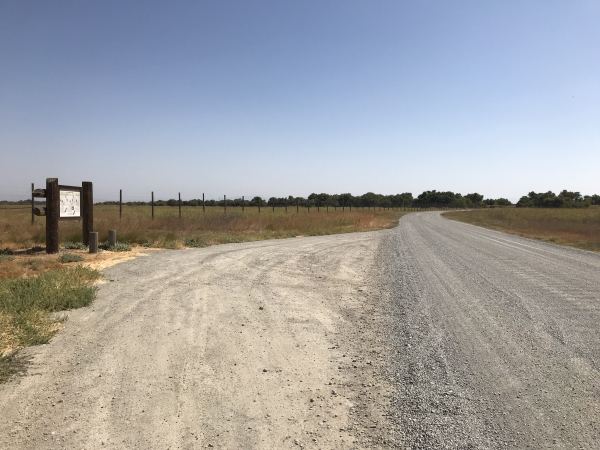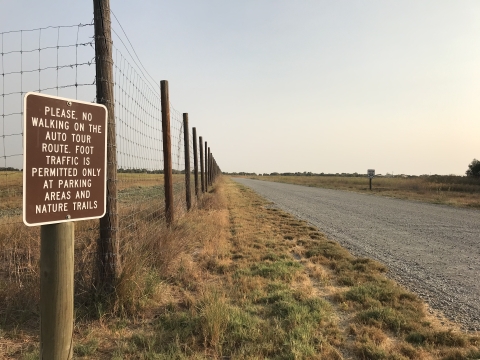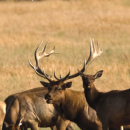
Enjoy the refuge auto tour routes for spectacular wildlife observation and photography experiences! All refuge complex auto tour routes are one-way unless marked otherwise. Please stay in your vehicle on auto tour routes, except at designated areas where signage indicates getting out is allowed. Many wildlife species are accustomed to slow-moving vehicles, so your automobile is often your best “blind.” No foot traffic, bicycles, or horses are allowed on the auto tour routes. The all-weather roads are constructed of compacted gravel and remain firm even during wet weather. During the hot dry days of summer, you are more likely to see a greater number of bird species in the morning – the next best time for summer birds is in the late afternoon/early evening. Likewise, most mammals, including the tule elk, are more likely to be visible in the morning or early evening during the hot months.
Waterfowl auto tour route
Length: 8.5 miles
Season: Open year-round
Access: Visitor Center/main refuge entrance
Road Surface: All-weather compacted gravel
The Waterfowl auto tour route meanders through the heart of the San Luis Refuge’s upland and wetland habitats. Thousands of wintering ducks use these wetlands during fall, winter, and spring. Large flocks of geese and sandhill cranes often can be seen during the winter season, and tundra swans are usually visible in one or more of the wetlands during the winter. Mammals, such as black-tailed deer and coyotes, are abundant on the refuge and seeing one is always a possibility. The variety of raptor species increases in the winter when peregrine falcons, bald eagles, and occasionally even golden eagles, hunt the Valley’s plentiful rodent populations. Spring, summer, and fall are bountiful times when dozens of songbird species either migrate through the riparian riparian
Definition of riparian habitat or riparian areas.
Learn more about riparian woodlands or move in for the summer breeding season.
From the Waterfowl auto tour route, visitors can access three nature trails – the Chester Marsh nature trail, the Sousa Marsh nature trail, and the Winton Marsh nature trail. Each trail has a trailhead parking lot for vehicles.
Tule Elk auto tour route
Length: 5 miles
Season: Open year-round
Access: Visitor Center/main refuge entrance
Road Surface: All-weather compacted gravel
The Tule Elk auto tour route guides visitors around the nearly 800-acre enclosure that is home to a resident herd of an endemic sub-species of North American elk known as tule elk. Tule is another name for bulrush—a large wetland plant. Tule elk nearly became extinct in the late 1800s when they declined to as few as 20 to 40 animals because of market hunting, habitat loss, and competition from introduced livestock. The refuge herd was established to help tule elk recover from the brink of extinction. Today, there are well over 4,000 tule elk in 22 herds throughout the state of California. Several interpretive panels located along the tour route provide information about the elk and other species of wildlife that depend on this upland habitat to survive. A wildlife viewing platform with a spotting scope located on the tour route provides an elevated view into the elk’s native grassland habitat.Interpretive panels mounted on the platform provide information about the habitat and other species that share the elk’s upland home. In addition to elk, birds abound along the route throughout the upland/grasslands and the riparian corridor adjacent to Salt Slough, a tributary of the San Joaquin River.
West Bear Creek auto tour route
Length: 2.25 miles
Season: Open seasonally when tour route wetlands are flooded (timing may fluctuate annually, but the unit generally is open fall through spring).
Access: West Bear Creek Unit entrance on Hwy 165
Road Surface: All-weather compacted gravel
The West Bear Creek auto tour route leads around and through the various wetlands of the San Luis NWR’s West Bear Creek Unit. Winter and spring are the busiest times for wildlife as scores of ducks can be found in the ponds and tundra swans occasionally make an appearance; surprises like Eurasian wigeon and horned grebes can also be seen. Secretive marsh birds like the Virginia rail and sora can often be heard, but rarely seen. Receding water levels in the spring draw hundreds to thousands of shorebirds of many different species, and senescent tule and cattail stands frequently host breeding colonies of yellow-headed blackbirds. Raptors can be seen soaring above the wetlands and uplands as they hunt for unwary ground squirrels and American coots. Black-tailed deer and river otter may make surprise appearances along the tour route. Other mammals such as coyote, black-tailed jackrabbit, desert cottontail rabbit, California ground squirrel, and raccoon are always present, but not always seen. The riparian corridor east of the auto tour route provides habitat for woodpeckers, raptors, owls, and many species of songbirds and neotropical migrant birds, especially during the fall and spring migrations. The Woody Pond and Raccoon Marsh Nature Trails are accessible from the West Bear Creek auto tour route.




